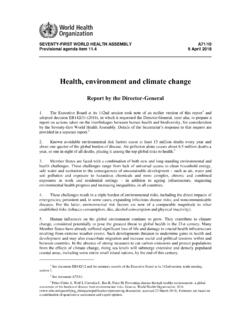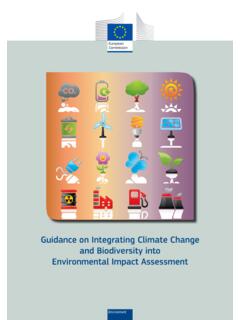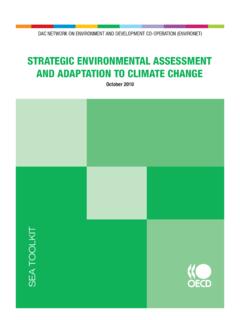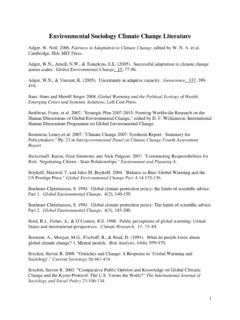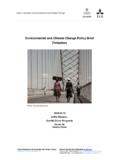Transcription of Health, environment and climate change - WHO
1 EXECUTIVE BOARD EB142/12 142nd session 22 December 2017 Provisional agenda item health , environment and climate change Report by the Director-General 1. Known avoidable environmental risk factors cause at least 13 million deaths every year and about one quarter of the global burden of disease. Air pollution alone causes about million deaths a year, or one in eight of all deaths, placing it among the top global risks to 2. Member States face a combination of long-standing unresolved and new environmental and health challenges. These range from lack of universal access to clean household energy, safe water and sanitation, to the consequences of unsustainable development, such as air, water and soil pollution and exposure to hazardous chemicals, and more complex, chronic and combined exposures in work and residential settings, and to ageing infrastructure, stagnating environmental health progress, and increasing inequalities, in all countries.
2 3. These challenges result in a triple burden of environmental risks, including the direct impacts of emergencies, persistent and in some cases expanding infectious disease risks, and noncommunicable diseases. For the latter, environmental risk factors are now of a comparable magnitude to other well-established risks (tobacco consumption, diet, alcohol consumption and physical inactivity). 4. Human influences on the global environment continue to grow. They contribute to climate change , considered potentially the greatest threat to global health in the 21st century. Many Member States already suffer significant loss of life and damage to crucial health infrastructure from extreme weather events. All these developments threaten to undermine gains in health and development, and may exacerbate migration and increase social and political tensions within and between countries. In the absence of strong measures to cut carbon emissions and protect populations from the effects of climate change , rising sea levels will submerge extensive and densely populated coastal areas, including some entire small island nations, by the end of this century.
3 5. Although the paramount concern is to protect human lives and ensure well-being, environmental degradation also has large economic costs to the health sector. Global health and welfare losses from air pollution in 2013 are valued at about US$ 5110 billion, or almost 7% of gross domestic 1 Pr ss-Ust n A, Wolf J, Corval n C, Bos R, Neira M. Preventing disease through healthy environments: a global assessment of the burden of disease from environmental risks. Geneva: World health Organization; 2016 ( , accessed 27 October 2017). Estimates are based on a combination of quantitative assessment and expert opinion. 2 World Bank Group, Institute for health Metrics and Evaluation. The cost of air pollution: strengthening the economic case for action. Washington, DC: World Bank; 2016 ( , accessed 30 October 2017). EB142/12 2 About 10% of global gross domestic product is now spent on health care,1 driven increasingly by the costs of treating noncommunicable diseases.
4 Failure to manage environmental risks and prevent a growing disease burden will therefore increase the strain on health services and national and household budgets. 6. The effects of human actions on the environment are an ethical and human rights issue, as they will be felt by future generations, and have the most severe impact on the most economically, demographically and geographically vulnerable populations. CURRENT STATUS OF THE PUBLIC health RESPONSE TO environmental AND climate change 7. Responsibility for and tools to tackle many environmental determinants of health lie outside the direct control of individuals or the health sector alone. Therefore, a wider societal, intersectoral and population-based public health approach is needed. 8. A wealth of evidence demonstrates the health impacts of individual environmental exposures, for example, to specific chemical or biological contaminants in water. At the same time, however, there is also strong evidence for the cost-effectiveness of many interventions, from small-scale (for instance, point-of-use water treatment) to large-scale investments (for instance, in sanitation infrastructure).
5 9. There have been notable successes in applying such evidence to intersectoral policy. Examples range from removing lead from petrol in many countries to controlling the depletion of the ozone layer and the associated health risks of ultraviolet radiation through application of measures set out in the Montreal Protocol on Substances that Deplete the Ozone Layer (1987). 10. In dealing with environmental , climate and other determinants of health , WHO promotes a health in All Policies approach, including coverage of health in environmental and labour regulations and safeguards, assessment of the health impact of development projects, and tackling several environmental health issues in a single setting, community or system. Numerous examples of best or good practice are available,2 but such integrated approaches are not applied universally, and are seldom directed to upstream environmental and social determinants (such as more sustainable and equitable resource consumption, climate stabilization and protection of biodiversity and ecosystem services) that in turn drive exposure to hazardous health conditions.
6 11. Many contemporary environmental risks to health are also interdependent and transboundary in nature. These range from the transfer of polluting industries, dangerous work processes, and hazardous waste to poorer and less regulated countries; to transboundary air pollution and radiation risks; and to burning of fossil fuels that drive global climate change . This transfer and extension of risk is occurring against a background of decreased direct investment and the lifting of restrictions by national governments, and an increasing influence of diverse, often politically and economically powerful and multinational, private-sector actors. 1 WHO. Global health Expenditure Database ( , accessed 8 November 2016). 2 Government of South Australia; WHO. Progressing the Sustainable Development Goals through health in All Policies: Case studies from around the world. Adelaide, Australia: Government of South Australia; 2017 ( , accessed 30 October 2017).
7 EB142/12 3 12. At the same time, there is continuous demand for more commonly recognized downstream environmental health interventions to deal with the direct and local effects of environmental risks to health most obviously in the case of responding to emergencies, which can in turn result in and from environmental degradation. 13. The persistent burden of environmental disease and the evolving range of risks clearly call for a strengthening of primary prevention. However, health sector engagement and investment have not increased proportionately to meet the need. According to OECD, Member States typically allocate about 3% of health expenditure to prevention, in contrast to the 97% allocated to curative 14. In confronting challenges of this scale, incremental changes to deal with individual environmental risks are not sufficient, and the environmental contribution to the global burden of disease has remained almost static for a decade.
8 Instead, the health sector must show leadership and work with other sectors to assume its obligations in shaping a healthy and sustainable future. THE TRANSFORMATION NEEDED: MORE EFFECTIVE UPSTREAM ACTION IN THE 2030 AGENDA FOR SUSTAINABLE DEVELOPMENT 15. The 2030 Agenda for Sustainable Development and its associated Sustainable Development Goals provide the integrated framework for the ambitious changes needed to fulfil the commitments made. The Goals and their targets provide the structure to identify and operationalize actions to safeguard and enhance the upstream determinants of health , and to follow a sustainable pathway to improved, and more equitably distributed health and well-being. 16. health is relevant to all the Goals, not just Goal 3 (Ensure healthy lives and promote well-being for all at all ages). Within the scope of environmental and climate change , there are specific and important opportunities for health gains through ensuring that health occupies a more dominant position in the agendas relating to nutrition (Goal 2, End hunger, achieve food security and improved nutrition and promote sustainable agriculture); water and sanitation (Goal 6, Ensure availability and sustainable management of water and sanitation for all); clean energy (Goal 7, Ensure access to affordable, reliable, sustainable and modern energy for all); decent work (Goal 8, Promote sustained, inclusive and sustainable economic growth, full and productive employment and decent work for all); sustainable cities (Goal 11, Make cities and human settlements inclusive, safe, resilient and sustainable); responsible production and consumption (Goal 12, Ensure sustainable consumption and production patterns).
9 And climate change (Goal 13, Take urgent action to combat climate change and its impacts). 17. The Goals therefore provide an opportunity for the health sector to engage in broad, inclusive and massively expanded primary prevention, effectively bringing together Principle 1 of the Rio Declaration on environment and Development (1992) ( Human beings are at the centre of concerns for sustainable development. They are entitled to a healthy and productive life in harmony with nature ) and Article 1 of the Declaration of Alma-Ata (1978) ( .. the attainment of the highest possible level of health .. requires the action of many other social and economic sectors in addition to the health sector ). 18. In the 21st century, health should therefore be central to discussions around drivers such as production methods that pollute, deleterious consumption and distribution patterns and disruption of 1 OECD.
10 OECD health Data 2006, Statistics and Indicators for 30 Countries. CD-ROM, Paris, 2006. EB142/12 4 ecosystems. Moreover, attainment of health should be promoted as an explicit aim, rather than an afterthought, in decisions in key sectors such as energy, transport, technology, water and sanitation, and urban planning. 19. Investment in the capacity of the health sector for policy engagement, assessment and monitoring of investments that are made in other areas of the economy would support promotion of mutually beneficial measures that simultaneously protect health and the environment . This approach would in turn avoid current or future economic costs, allowing reinvestment in health and sustainable development. 20. For example, more sustainable urban transport systems that promote public transport, cycling and walking would reduce air pollution, noise and risk of road traffic injuries, and enhance physical activity levels.










